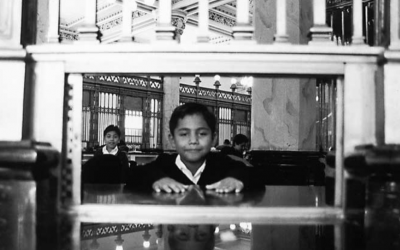Where the Patient Still Thinks…
The Doctor Knows Best
Like a row of dolls they sit in the clinic waiting room—a dozen or so 14- and 15-year-old girls—all dressed nearly identically in navy blue school uniforms. With the television blaring real-life family drama overhead, we float about, getting charts and pill packs, getting ready for the next patient. It is another morning in the Santiago de Chile adolescent health clinic where I am interning and treating patients as a fourthyear medical student. I call out the next name and find my patient—a slip of a girl with frosted purple eye shadow with an uncertain, gangly gait favored by adolescents and baby deer—and walk her into the exam room. She sits, and with little preamble, the doctor of the day begins to ask excruciatingly detailed questions about her sexual activities. I watch, curious to see her reaction to his seemingly invasive interview. She seems comfortable enough with all of this, answering him easily, and ventures that she would prefer monthly injectable birth control. The doctor curtly replies that he does not think she needs anything other than standard oral contraceptive pills and points for her to undress for her internal exam.
Behind a completely inadequate curtain she calmly undresses while the doctor finishes his note and I scramble to prepare her for the exam. Ready for her exam, she lies in stirrups and draped as secretaries and other physicians come in and out of the room without knocking, the curtain barely shielding her from the traffic moving to and fro, the doctor talking to others while she waits. She sits up expectantly as we finish her exam, and the doctor tells her that he has decided that she will take the Pill and needs to return in two months. With a nod of his head and eyebrows she is dismissed, dashing out of the exam room and back to school with a backwards glance and friendly smile.
Probably the most amazing facet of this clinical situation is that the adolescent in question was even able to be there at all. As I learned from many conversations with my Chilean colleagues in obstetrics and gynecology and social services, adolescents in Chile face many difficulties and potential barriers in caring for their reproductive health. As in many other South American countries, abortion is absolutely illegal, requiring government permission even if a mother’s life is at risk, mostly due to the strong influence of the Catholic Church. An illegal abortion occurs every five minutes in Chile, either surgically or through mifepristone (RU-486), both of which can cause life-threatening health effects such as sepsis or hemorrhage. Adolescents who find themselves pregnant and choose to marry are facing a lifelong decision without recourse or solution, as Chile is the world’s only democracy without a divorce law, another result of the very strong influence of Catholicism in Chile. Cultural hesitancy about sex education limits the availability of important knowledge about sexuality and reproduction, although in many comunas and cities colegios are now more likely to offer inclusive sex education. Finding her way to our clinic door before a pregnancy occurred was an accomplishment in and of itself, regardless of the visit’s outcome.
Yet at the time of the visit described above, I was startled by the maturity of the adolescent in question and the callousness and paternalism of the doctor; either way, I initially saw this visit as a less-than-pleasant anomaly. However, while working independently as an intern, I soon discovered that most of the patients I saw were fairly comfortable with the extensive questions about the most personal aspects of their sexual lives, the clinical commotion that frequently disrupted pelvic and other private exams, and the fact that doctors sometimes make decisions regarding their care that directly oppose what they might prefer.
Cultural differences regarding modesty and expectations of a medical setting notwithstanding, the most striking thing to me about the aforementioned visit and my work in Santiago as a healthcare provider in general were the profound cultural differences in the patient-doctor relationship. In an effort to explain to me his clinical reasoning during the young girl’s visit, the physician with whom I worked that day, along with many other of my colleagues in Santiago, explained to me that the physician’s goal in any clinical encounter was to decide what was best for the patient. His job was not to be a friend, or an intermediary between her and her parents, but to protect her welfare and do what he thought best; this is the reason patients come to a physician. This is especially true with adolescents, where a physician must act in place of her parents in granting her permission to use birth control—while they frequently do not want to involve their parents, they do want some adult to take charge of this matter for them.
So, far from being affronted that her doctor was acting, as Ferris Bueller would put it, as a parental unit, the 14-year-old girl we just saw expected that type of relationship with her doctor, and trusted that we would only do was needed to take care of her needs. In fact, most patients in Chile seem to desire that type of relationship, and absolutely trust their physicians—a stunning contrast to the litigation-ridden healthcare industry in the U.S.
And it is this lack of industry that seems to make all the difference, although cultural expectations and sexual politics undoubtedly make a huge impact as well. While there are many private and highly profitable hospitals and clinics in Santiago, doctors in Chile are typically not wealthy compared to their U.S. counterparts; most struggle for income and must pay for a costly education. As a resident told me during my second week, patients in Chile know that their doctors must be dedicated to medicine to pursue it and thus will do for them everything that needs to be done. Perhaps the one benefit to the financial disarray of the U.S. medical system will be the possibility of re-equilibrating patient-physician relationships and enhancing patient trust in the physician who they know is present for only one reason—to take care of them.
Winter 2004, Volume III, Number 2
Tarayn Grizzard is a 4th year Harvard Medical School student who spent the summer of 2002 in Santiago de Chile working in an adolescent reproductive health services clinic courtesy of a DRCLAS internship grant.
Related Articles
Editor’s Letter: The Children
A blue whale spurts water joyfully into an Andean sky on my office door. A rainbow glitters among a feast of animals and palm trees. Geometrical lightning tosses tiny houses into the air with the force of a tropical hurricane.
Centroamerica
Cuando Pedro Pirir, fue despedido del taller mecánico donde trabajaba desde hacía muchos años, experimentó una sensación de injusticia y pena que luego se transformó en una voluntad…
Irregular Armed Forces and their Role in Politics and State Formation
As I sat in heavy traffic in the back of a police car during rush hour in the grimy northern zone of Rio de Janeiro, I studied the faces of drivers in neighboring cars, wondering what they thought of…




